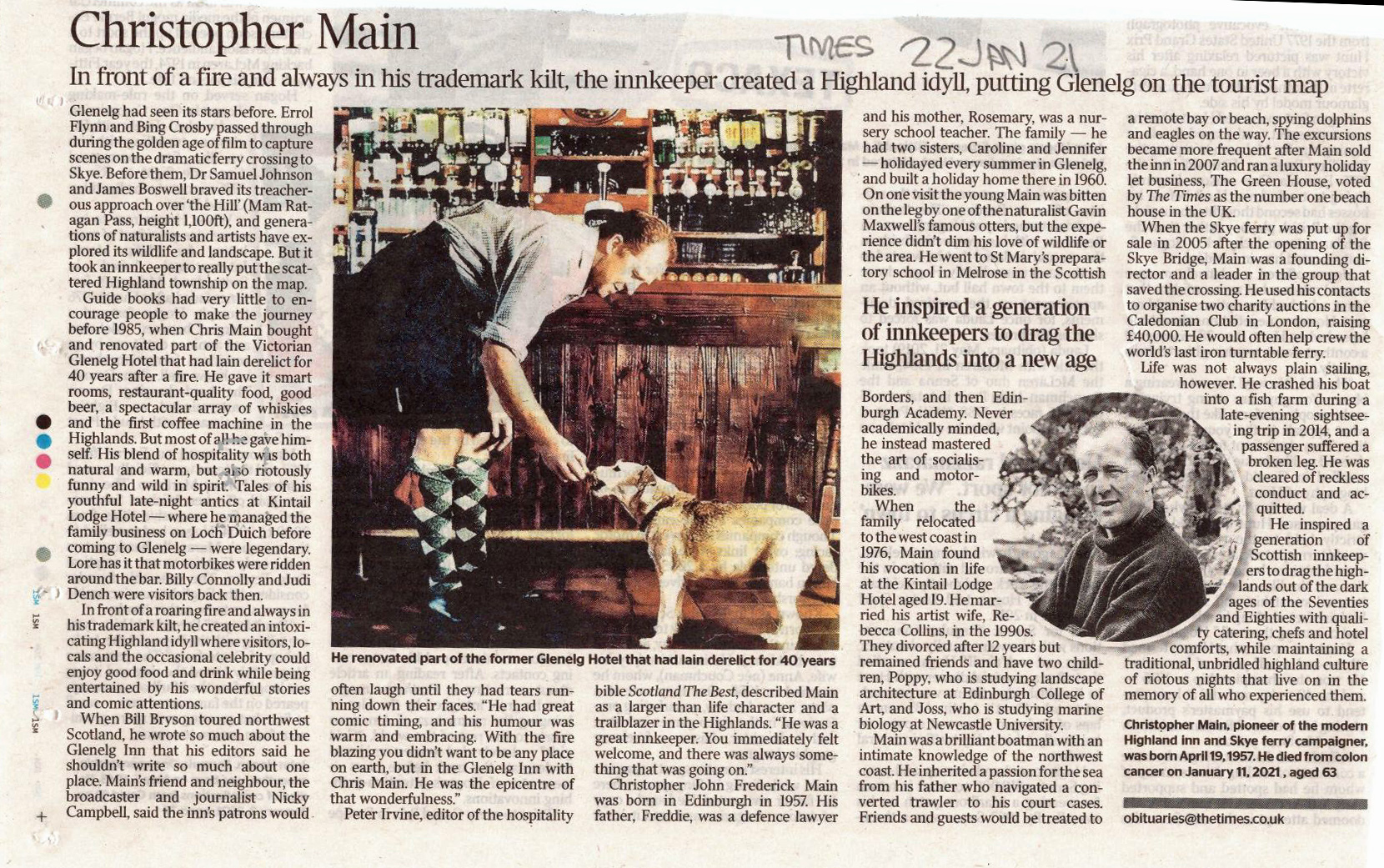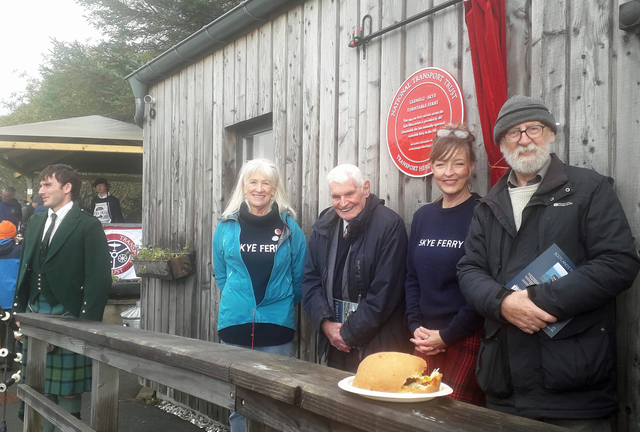
This 1934 car ferry service across the Kyle Rhea straits is provided by MV Glenachulish, the last manually-operated turntable ferry in the UK
Glenelg
A seasonal ferry with a capacity for six cars operating every 20 minutes that links the mainland at Glenelg with Kylerhea on the Isle of Skye and is thus midway between the Mallaig-Armadale crossing to the south and the Skye Bridge to the north. The Glenelg Ferry slipway was designed by Thomas Telford in 1818 and is Category B listed
MV Glenachulish is in regular service between Easter and October and is maintained by the Isle of Skye Ferry Community Interest Company, which holds a Loadline Exemption certificate from the MCA. In 2010 the company spent £60,000 overhauling the keel and hull.
In May 2023 it was featured on BBC News:
Once a common sight throughout the Highlands, 'wee ferries' were the road links before the building of bridges. The Glenachulish ferry was built in 1969 to work the crossing at the head of Loch Leven between Ballachulish (Argyll) and North Ballachulish (Inverness-shire) on the main (A82) west coast road between Glasgow and Inverness. The Glenachulish was in service until the Ballachulish ferry closed in December 1975.
In 1983 she came to Glenelg, the closest landmass to the Isle of Skye, to ply the Kyle Rhea Narrows, the oldest and fastest ferry route to the island. This is where Vikings crossed the surging straits coping with the eight knot current, and drovers brought herds of Hebridean black cattle to swim across from Kylerhea on Skye to Glenelg and continue their way south to market - a head count of some 8,000 beasts per year. There has been a car ferry service here since 1934, although there was an extended break through the Second World War when access to local waters was restricted due to their importance as a centre for naval operations.
MV Glenachulish built by Ferguson-Ailsa Ltd of Troon
Length Over All: 58.14 feet (17.52 m)
Beam 21.49 feet (6.55 m)
Draught 5.91 feet (1.80 m)
On 1st May 2021 BBC Today interviewed Jo Crawford, General Manager of the Skye Ferry.
A recording of the interview can be downloaded / played here.
On 11th January 2021 the prominent Skye Ferry campaigner Christpher Main died of cancer age 63
His obituary was published in The Times 22nd January 2021 can be downloaded here

Transport Digest magazine published a superb article by JO CRAWFORD in the Autumn 2021 edition 144 covering the history and restoration of the ferry - the following is an extract:
HISTORY THE FERRY
The MV ‘Glenachulish’ was built at the Ailsa Shipbuilding Company in Troon in 1969 and launched for service at Ballachulish where she served
until 1975. After the opening of the Ballachulish Bridge, she became the relief ferry at Corran, Kessock, and Kylesku. The latter two routes have since been replaced with bridges. She came to Glenelg in 1982, having been bought by the ferry operator there, Mr Murdo MacKenzie. In 2005 the owner, Mr Roddy MacLeod, put the boat up for sale after the tolls were removed from the newly built Skye Bridge. A small group of local people from both sides of the Kylerhea narrows, fearing for the sustainability of the area without the ferry, set up the Isle of Skye Ferry Community Interest Company, to try to secure the service and the crossing for future generations. The CIC was able to lease the boat in its first year and secured a grant to buy it in the second.
The Isle of Skye Ferry CIC has marketed the ferry as a unique visitor experience, while being mindful of the responsibility to its local community, and has grown the business year on year since it 2005.
The vessel remains the only working manually operated, turntable ferry in existence.
The crossing between Glenelg on the mainland and Kylerhea on the Isle of Skye is the point where the two land masses are at their closest and is the original access point from the Hebrides to the mainland of Scotland. Indeed,
it is part of a historic drover’s route where the cattle would swim across at slack tide, en route to market in the Central belt of the Scottish mainland. The original cattle ramp can still be seen adjacent to the slipway at Glenelg.
The two slipways at either side, Kylerhea and Glenelg, were designed by the great Thomas Telford and is described in www.historicenvironment.scot: “Built by world-renowned engineer Thomas Telford and his associates,
the Glenelg slipway, along with its counterpart slipway at Kylerhea, marks the shortest and most historically significant crossing place between mainland Scotland and the Isle of Skye. This was the primary cattle droving route out of the islands. The Glenelg slipway includes a rare cattle droving slip understood to be the only one of its kind in Scotland. It is innovatively incorporated into the design by Telford and clearly evidences its earlier historic use. A passenger ferry service is also recorded as operating at this location in the 17th century. It was part of General Wade’s military road system in the mid 18th century.”
THE FERRY ITSELF
Since taking ownership of the ferry, the ferry company has invested significantly in its preservation and maintenance.
In June 2011, the Glenachulish Preservation Trust (Skye ferry Charity) was set up by Dr Jennifer Frances and the late, great Mr Christopher Main, both of Glenelg, in order to raise funds to ensure the preservation of the boat, in, or out of the water, in recognition of her importance as the last of her kind. To date the charity has raised over £120,000 which has enabled restoration work on the original Kelvin T6 engine, replacement of the original wheelhouse, repair and preservation works on the unique turntable mechanism, partial replacement of hull sheeting and numerous other restoration works that have been carried out in order to preserve this unique vessel.
CURRENT OPERATIONS
The Isle of Skye ferry Community Interest Company has had ownership of the ferry since 2005 and operates the service between Glenelg and Kylerhea from April to October, seven days a week every year. The company has marketed the ferry as a unique visitor experience and has seen passenger numbers grow significantly to almost 40,000 passengers in the seven month season for the last few years. That amounts to 13,500 vehicles carried across the narrow straits on board probably one of the smallest vehicle ferries in the world – no mean accomplishment for the company and, of course, for the crew who work tirelessly to provide an enjoyable and memorable experience for all of our visitors.
The company remains mindful of its duty to the local communities it serves and provides subsidised travel for local residents to the tune of £20,000 each year as well as supporting local causes and projects wherever it can. The
ferry and the visitors it undoubtedly attracts has measurable benefits for the local community, providing well paid, sustainable employment and training opportunities, supporting local businesses such as the local shop, hotel, café and accommodation providers. Glenelg would be a much poorer place, in all of the senses of that word, without the ferry.
LOCATION
The crossing that the wee ferry plies is the closest point between the Isle of Skye and the Scottish mainland.
To get to Glenelg, the Mam Ratagan mountain pass has to be traversed, a winding single track (in places) road that climbs to over 350m (1,140 ft), affording spectacular views of the mountain range the Five Sisters of Kintail.
UNVEILING
The Red Wheel heritage plaque was erected during the Covid pandemic in early 2022 - a formal unveiling took place on 25th September 2023. NTT Vice President John Cameron CBE unveiled the plaque together with Jo Crawford and Dr Jennifer Francis

From Glasgow
The A82 will take you alongside Loch Lomond to Crianlarich. Turn left there and continue through Tyndrum and Glen Coe and onwards to Fort William. Continue to Spean Bridge and on to Invergarry. There you should turn left towards Kyle of Lochalsh. This road ends at a junction where you should turn left until you reach Shiel Bridge. Here is where you turn left over the small bridge and over the hill to Glenelg.
From Inverness
The A82 will take you to Invermoriston where you turn right onto the A887. Continue until you reach Shiel Bridge. Here you will turn left over the small bridge and over the hill to Glenelg.
Over the hill
A mountain pass, constructed in 1815, leads from Shiel Bridge to Glenelg. From sea level it twists and turns towards the summit of Mam Ratagan before making a more gradual descent. 30 minutes for the journey from Shiel Bridge to the ferry should be sufficient.